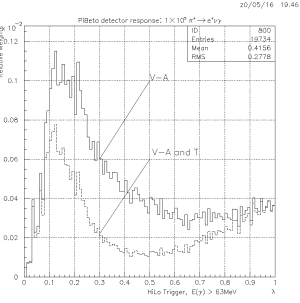 PS
PS
We discussed earlier in the PiBeta collaboration the possibility and desirability of the precise measurement of radiative pion decays. For this measurements the new trigger HiLo was proposed. The HiLo trigger has high efficiency and the statistics for pion beta and radiative decays could be obtained simultaneously by measuring decays of pions stopped in the target.
The precise measurement of radiative pion decays will allow one to find out for sure if a tensor interaction makes any contribution to this decay. The Standard Model allows here only V-A interaction. For instance, the ISTRA collaboration [1] claimed existence of tensor charged-current interaction (T) contribution to the decay. Destructive interference between the standard amplitude and a non-conventional amplitude of the tensor type can lead to a lack of events observed in the ISTRA experiment. The authors obtained the tensor interaction term in the amplitude FT=-(5.6+/-1.7)x10-3, and considered this value as an upper limit on |FT|< 10 -2. It corresponds to a coupling constant fT of about 10-2 whereas even in supersymmetric extensions of the standard model the maximum value of fT is 10-4 - 10-5 [2]. Nevertheless somewhat exotic models [3,4] were proposed to explain the ISTRA result.
In [5] it was proposed to improve constraint on the tensor coupling constant by measurement of the radiative pion decay in a region of phase space where searching of tensor interaction is optimal. At large photon energies the contribution from tensor interaction is maximal whereas contributions from inner bremsstrahlung of the positron and pion is minimal and the structure-dependent part of the amplitude is small. The shape of differential decay rate is sensitive to possible tensor contribution if considered as function of variable L=(x+y-1)/x for range 0.2 < L < 0.8, where x = 2EGamma/mpi, y = 2Ee/mpi.Kinematics of this process allows to separate the region where structure-dependent contribution (SD) is dominated over uninteresting inner bremsstrahlung (IB). SD is parametrized with vector (FV) and axial-vector (FA) form factors. So in the Standard Model V-A approach one can test predictions of different strong interaction models.
The main goals of the measurement are:
A simulation of PiBeta calorimeter with HiLo trigger ensures a substantial suppression of the IB contribution. For ISTRA value of FT the ratio |IB|/|SD|/|T| is about 260/1/2 for all decay events whereas for triggered events this ratio is 6/1/1. The very preliminary results of radiative pion decays with and without tensor interaction one can see on Fig1:
The registration efficiency of radiative pion decay events is about 1% for such a trigger. For events with large photon energies (x > 0.9) the registration efficiency is about 8%, but the majority of such events rejected by the trigger lies in the range L < 0.2. The registration efficiency of the main physical background (pi -> e nu decay) is about 0.2%. A calculation of the radiative pion decay rate for photons with energy > 5 MeV gives 3.84x10-6. We expect about 1.2x10-7 radiative pion decay triggers per one pion decay (without prescaling) or 5.2 of these triggers (prescaling factor = 4) per one PiBeta decay. In the interesting region (EGamma > 63 MeV) we expect about 0.7 radiative pion decays (prescaling factor = 4) per one PiBeta decay. It means that in statistics equivalent to 104 PiBeta decays we will have 7000 radiative pion events. We can determine the tensor interaction on the level of a few percents.
So this trigger is rather suitable to investigate possible tensor contribution in the most sensitive region of phase space. On the other hand, one can see that all "PiBeta" events are selected by "PiBeta Hi" trigger will be selected by "HiLo" trigger also.
[1] V.N.Bolotov et al., Phys.Lett. B243 (1990) 308.
[2] V.M.Belyaev and Ya.I.Kogan, Preprint UBCTP 91-38 (1991).
[3] P.Herczeg, Phys.Rev. D49 (1994) 247.
[4] L.V.Avdeev and M.V.Chizhov, Phys.Lett. B321 (1994) 212.
[5] A.V.Chernyshev et al., Mod.Phys.Lett.A, Vol.12, No.23 (1997) 1669.